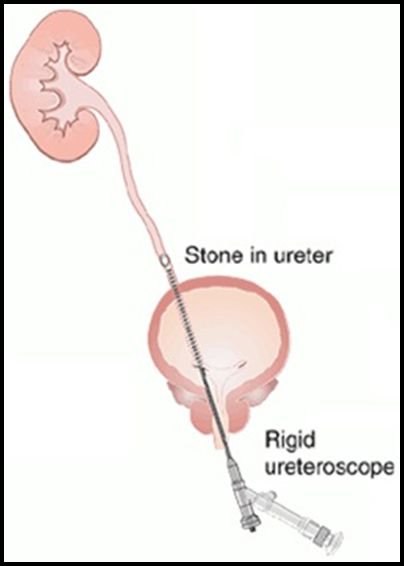Ureteroscopy
URS (Semi Rigid And Flexible)
Laser Stone Surgery using Rigid Ureteroscopy What is it?
Ureteroscopy is where a long thin, rigid telescope is introduced into the upper urinary tract via the bladder. The diameter of the instrument is less than 3 mm and allows visualisation of the lower half of the ureter. A small instrument port enables the introduction of micro-baskets, Lithoclast (pneumatic device to break the stone) and laser fibres (0.3 mm in diameter) to manipulate and fragment stones.

WHAT ARE THE MAIN ADVANTAGES OF THIS APPROACH?
- Allows stone treatment without the need for any incision by using the urethral orifice as the entry point
- A highly successful technique (over 95%)
- It can be performed as day surgery
- More invasive compared to shock wave lithotripsy
- Slight risk of damaging the ureter (0.5%)
WHAT ARE THE MAIN DISADVANTAGES?
- More invasive compared to shock wave lithotripsy
- Slight risk of damaging the ureter (0.5%)
WHAT PREPARATION IS REQUIRED?
As the procedure is performed under general anaesthesia, you should have nothing to eat or drink for 6 hours before treatment. Regular medications can be taken with a sip of water except for blood thinning agents (e.g. warfarin, aspirin, clopidogrel), which must be stopped for 7-10 days.
WHAT DO I NEED TO BRING TO SURGERY?
- All related imaging such as x-rays, CT scans or ultrasound
- Your usual medications
WHAT HAPPENS IN THE OPERATING ROOM?
You will meet your anaesthetist before surgery, who will take a thorough medical history. This person will be responsible for your safety under general anaesthesia. The procedure will usually take 60 minutes and involves putting a rigid telescope into the kidney’s drainage tube (ureter) and fragmenting the stone with a laser. A temporary urinary stent may be left in place for a short period to ensure the kidney drains without risk of blockage.
WHAT ARE THE RISKS?
This is generally considered a very safe operation.
Specific risks to surgery include:
infection, minor bleeding, and perforation of the ureter (1 in 200), very rarely avulsion of the ureter.
WHAT TO EXPECT AFTERWARDS?
It is normal to feel the need to pass urine frequently and notice blood in the urine following surgery. This will settle over the ensuing days. You will sometimes have a temporary urinary stent following surgery which allows the swelling in the ureter to settle from where the stone was located.
FOLLOW-UP
You will be advised after surgery of the necessary follow-up arrangements. A script for oral antibiotics will need to be taken for 3-5 days to prevent infection. You need to drink at least eight glasses of water a day (2.5L/day) if no fluid restriction is there. You will not be able to drive for at least 24 hours after surgery as you have had a general anaesthetic.
LASER STONE SURGERY USING FLEXIBLE URETEROSCOPY WHAT IS IT?
Pyeloscopy is where a thin fibre-optic telescope is introduced into the kidney from the bladder via the urethra (see diagram). The diameter of the instrument is less than 3mm and allows visualisation of the entire kidney drainage system due to the flexible nature of the scope. It contains a small instrument port that enables the introduction of laser fibres (0.3 mm diameter) to efficiently fragment stones and micro-baskets (less than 1mm wide) to retrieve stone fragments. Kidney stones up to 2 cm in size can be treated using this approach.
